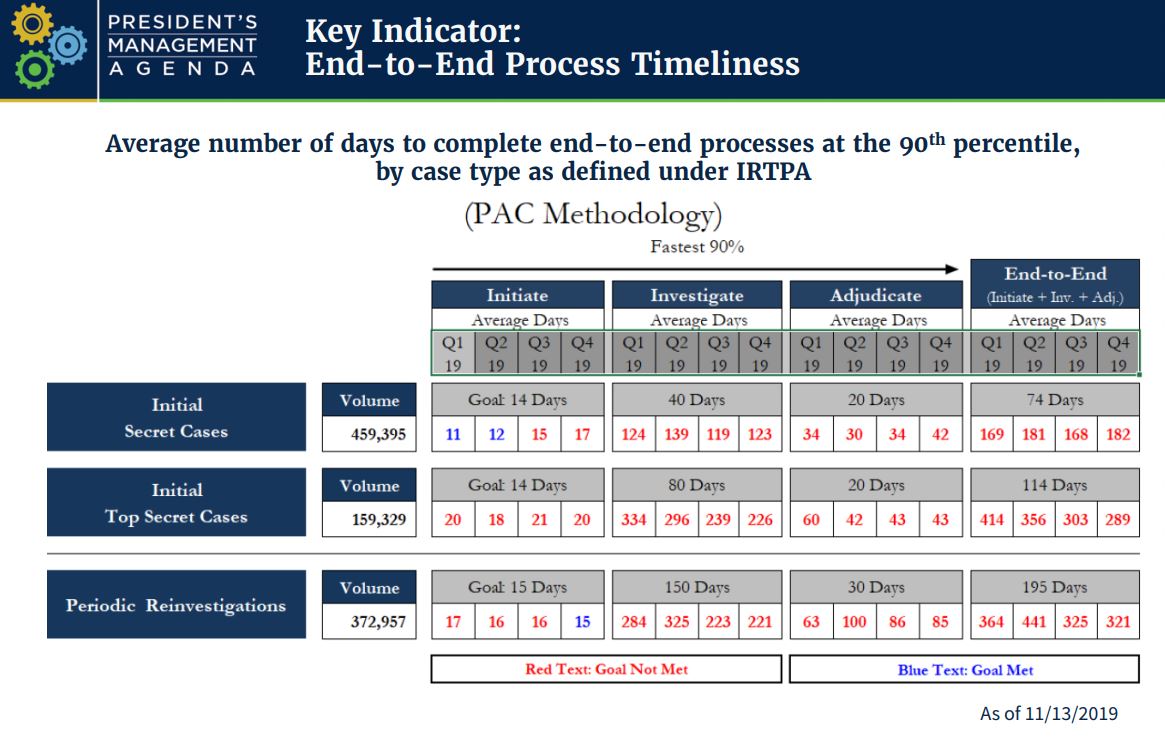Progress on security clearance backlog is real, but federal contractors still seeking end-to-end solutions
Federal contractors are pleased with the progress the Defense Counterintelligence and Security Agency has made in slashing the background investigation inventor...
Slashing the security clearance backlog by nearly 500,000 in less than two years — by all accounts — is one of those coveted, good news government stories.
Transferring the people, resources and security clearances themselves from the Office of Personnel Management and National Background Investigations Bureau to the Pentagon’s newly renamed Defense Counterintelligence and Security Agency — with relative ease — is another feat.
But when it comes to the suitability, credentialing and the security clearance process, recent success at DCSA — and the National Background Investigations Bureau before it — only address one piece of a multi-faceted and complex puzzle.
“Our fears have not materialized so far, and the reports are that the transfer has gone fairly smoothly,” Rep. Gerry Connolly (D-Va.), chairman of the House Oversight Reform Subcommittee on Government Operations, said Monday of DCSA.
He hosted a roundtable of federal contractors at George Mason University.
But federal contractors say they’re still searching for solutions that address the end-to-end suitability, credentialing and security clearance process.
They say their new hires are still waiting far too long for a clearance, and many young professionals are giving up halfway through the process to accept another job somewhere else.
In 2018, 10,000 contract positions critical to the functioning and mission of the intelligence community remained unfilled due to security clearance delays, ManTech has said.
But the big fixes are supposed to be coming soon. The Trump administration is planning to roll out a series of sweeping changes to the suitability, credentialing and security clearance process, an initiative called “Trusted Workforce 2.0.”
By all accounts, industry has welcomed these planned changes. The defense and intelligence communities drew on industry feedback and ideas to develop Trusted Workforce 2.0, and contractors have applauded the effort.
“We have agreement in this room as to what most of the problems are, but we don’t often have that same agreement from the executive branch side,” David Berteau, president and CEO of the Professional Services Council, said. “For instance, in the Department of Homeland Security where we know reciprocity is a problem across the board, the department itself denies that they have a problem. This is an important role that you all can play to make sure the government admits it has a problem.”
Connolly said he’s approaching the progress with the security clearance inventory with a dose of “healthy skepticism.” He’s collecting industry feedback and recommendations now, which will inform a hearing with defense and intelligence officials in the coming months.
Progress on security clearance backlog is real
For the most part, federal contractors are pleased with the progress DCSA has made on the security clearance backlog itself. Even better, DCSA’s own reporting on the progress appears to ring true to federal contractors.
“Clearly on the DoD side they have gotten control of the inventory,” Greg Torres, director of personnel security for Booz Allen Hamilton, said. “People were worried about the 200,000 number. I would say don’t worry about the number, worry about the speed. Speed is getting better. From our perspective what the government is saying about how long it’s taking on the DoD side for the investigation is accurate.”
DCSA has also sped up the background investigation process itself, and contractors are taking notice.
The fastest 90% of initial top secret cases took 289 days to complete, according to a December update on Performance.gov. In early 2019, it took 414 days to finish an initial top secret clearance.

“In the last three-to-four months, we’ve noticed accelerated processing from [DCSA],” Elsa Lee, CEO of Advantage SCI, a veteran-owned, certified small business. “I think they were overwhelmed and challenged, but somehow they made it come together.”
Still, industry is looking for more data on the remaining 10% of background investigations that surpass the quarterly average.
If DCSA continues to complete about 700,000 cases a year, the public won’t see processing data for about 10% of the agency’s caseload, or about 70,000 background investigations a year, Torres said.
That still leaves plenty of cases for Congress, industry and the public to point to as examples where the security clearance process easily surpasses the reported quarterly averages.
Adjudications still slowing down security clearance process
Contractors say they’re seeing less progress with adjudications, considered the final “step” of the end-to-end background investigation process.
A backlog of unprocessed cases at the Defense Department’s Consolidated Adjudications Facility (DoD CAF) had ballooned to 200,000 at the beginning of 2019.
“It’s all over the map. In the case of the DoD CAF, they were doing well for a while. They are slipping a little bit right now; I don’t know why. The goal to be under 20 days, they are not there for industry,” Torres said. “We need to understand better how that’s going. [For] each of the intelligence agencies, their adjudications are also over the map. There’s one intel agency that I know takes them two-to-three months.”
According to the recent Performance.gov update, adjudications across government took, on average, 42 days for initial secret clearances and 43 days for initial top secret cases.
The fastest 90% of adjudications should, according to congressional mandates, take about 20 days.
“It seems like it’s self-defeating if we can speed up and expedite and streamline the process of background checks, great. But if… nothing happens and nothing’s improved with the adjudication it seems self-defeating,” Connolly said. “We need to make progress on both.”
But for many contractors, progress on the security clearance inventory has been easier to track than delays on the adjudication side.
“We could focus on the investigation backlog because we had the data,” Berteau said. “We couldn’t focus [and] we couldn’t get the same attention on the adjudication backlog because we didn’t have the data.”
Per a new provision in the 2020 defense authorization bill, Congress now requires regular, governmentwide reports on the status of security clearance adjudications. The first report is due to Congress in April, Connolly said.
Copyright © 2024 Federal News Network. All rights reserved. This website is not intended for users located within the European Economic Area.
Nicole Ogrysko is a reporter for Federal News Network focusing on the federal workforce and federal pay and benefits.
Follow @nogryskoWFED





